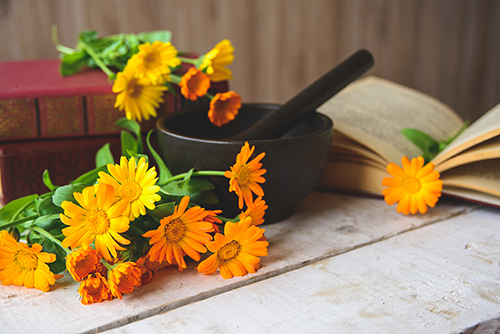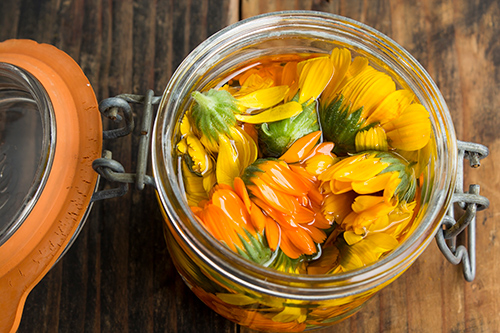Calendula, also called garden marigold, is a living example of how beauty and usefulness can go hand in hand. Calendula flowers open to the morning sun, showing their beautiful colors. In the evening, they close quietly until the following day.
People supporting the theory of signs, including Paracelsus and other Renaissance physicians, recommended calendula for jaundice and gall bladder disorders because of the bile-like color of its flowers. Those pioneers of medicine were not so wrong; since now we know its properties on a scientific basis, calendula is still used for the same purposes and for other ones that have also been discovered.
- ORGANIC WHOLE CALENDULA FLOWERS (CALENDULA OFFICINALIS) – 4oz Resealable Bag
- IMPORTED FROM EGYPT – This bag contains certified organic, calendula flowers from Egypt.

Calendula Scientific Facts
- Other names – Garden marigold, holigold, marigold, Mary bud, pot marigold.
- Scientific name – Calendual officinalis L.
- French – Souci des jardins.
- Spanish – Calendula.
- Environment – Native to Egypt, it is now cultivated in gardens as an ornamental flower throughout Europe and America, but it can also be found wild.
- Description—This herbaceous plant of the Compositae family grows from 30 to 50 centimeters high. It has elongated, toothed, fleshy leaves and exuberant yellow or orange flowers.
- Parts of the plant used medicinally – The flowers.
Healing Properties

The flowers of this plant contain carotenoids (provitamin A), a bitter component (Calendine), flavonoids, saponins, resin, essential oil, and small amounts of salicylic acid. All these substances combine themselves to turn this flower into a precious remedy. Its most outstanding properties are as follows:
- Emmenagogue and menstrual regulator – The plant is useful both for scanty menstruation due to its emmenagogue properties and when there is excessive bleeding. Therefore, calendula normalizes both the frequency and the quality of menstruation. It also eases the pain caused by menstruation (dysmenorrhea) since it has spasmolytic (combats painful spasms) and mild sedative properties. It must be taken from one week before the menstruation period until it has ended. Results are noticeable.
- Choleretic – It increases bile production in the liver. The plant is thus recommended for liver congestion or insufficiency.
- Antiulceration – Calendula can heal stomach and duodenal ulcerations. Its effects are more intense when taken in association with nettle and speedwell. Due to its healing and anti-inflammatory properties, it is also effective for gastritis (stomach inflammation), gastroenteritis, and vomiting.
- Anti-inflammatory, antiseptic, and healing – This is one of the most outstanding plants for its vulnerary properties, which is to say, for healing wounds and bruises. When locally applied, it notably speeds up wound healing, even when infected, and skin sores, burns, furuncles, and eczema. When applied to joints, it has antirheumatic properties.
- Wart remover – In local applications, the skin’s viral (common) warts disappear. The salicylic acid causes this effect in it.
- Emollient – (skin soothing). Calendula oil soothes and hydrates the skin. It is recommended for dry or delicate skin and children. The oil and the cream render relevant results for treating burns and eczema.
Calendula can be utilized as a non-irritating salve or fomentation for wounds, hemorrhoids, bleeding, burns, and sores. It is gentle on the skin and reduces inflammation. The plant treats eruptive skin diseases, fevers, ulcers, and cramps with a warm infusion. In addition, it has been used successfully as a nasal wash for sinus conditions.
Gastrointestinal problems such as diarrhea, stomach cramps, colitis, and ulcers can be treated using an infusion of the flowers (the whole head or the rays). Warm infusions of the herb are beneficial in recurrent vomiting, abscesses, boils, and fevers. Fresh juice from flowers or herbs can be a substitute for infusion.
The tincture helps with cramps, ulcers, vaginal infections, menstrual difficulties, and gastritis. Measles and smallpox can also be treated with the infusion. Calendula tea, made with one ounce of herb per pint of water, can be taken every hour for acute conditions. It is primarily used for making salves and is an excellent first-aid remedy.
Calendula used with oil in a poultice or salve can soothe pain and irritation, promote healing, mend wounds, and stop bleeding. The juice from dried flowers, leaves, or tincture also makes a perfect salve for injuries. The diluted tincture or ointment is also great for boils, sores, pulled muscles, bruises, and sprains. In addition, you can eliminate warts by rubbing them with fresh juice. People suffering from earaches can find relief by putting the oil in their ears overnight. A sitz bath with a strong calendula tea can be helpful against bleeding hemorrhoids. Varicose veins can be treated with a fomentation. The herb is also suitable for skin ulcers, bee stings, and wound washing.

How to use Calendula
- Infusion with 1 to 2 flowers per cup of water.
- Compresses and baths with a decoction made with two handfuls of flowers per liter of water. Apply to the affected area.
- Poultices with fresh flower petals were applied and wrapped on a fine cotton cloth.
- Lotion with fresh juice of flowers applied to the affected skin area.
- Oil – It is directly applied to the skin and can also be added to the bathwater to achieve a pleasant, soothing effect.
- Cream – It can be prepared by pressing one hundred grams of fresh flowers and mixing the resulting juice with five hundred grams of butter or other fatty substance.
Infusion: Steep for five to fifteen minutes. Take one tablespoon each hour or one cup daily. Fluid Extract: Take ½ to one teaspoon three times a day. Powder: Take three to ten #0 capsules (15 to 60 grains) daily.
DISCLAIMER: All content on this website is presented solely for educational and informational objectives. Do not rely on the information provided as a replacement for advice, diagnosis, or treatment from a qualified medical expert. If you are pregnant, nursing, or have any preexisting medical concerns, talk to your doctor before using any herbal or natural medicines.
REFERENCES
- George D. Pamplona-Roger, M.D. “Encyclopedia of Medicinal Plants.” George D. Pamplona-Roger, M.D. Encyclopedia of Medicinal Plants. Ed. Francesc X. Gelabert. vols. 2 San Fernando de Henares: Editorial Safeliz, 2000. 626, 627. Print.
- Vance Ferrell Harold M. Cherne, M.D. The Natural Remedies Encyclopedia [Book]. – Altamont, TN: Harvestime Books, 2010. – Vol. Seventh Edition: 7: pp. 149.
- Jiménez-Medina, E., Garcia-Lora, A., Paco, L., Algarra, I., Collado, A., & Garrido, F. (2006). A new Calendula officinalis extract produces a dual in vitro effect: cytotoxic anti-tumor activity and lymphocyte activation. BMC Cancer, 6, 119.: https://pubmed.ncbi.nlm.nih.gov/16677386/
Last update on 2025-06-04 / Affiliate links / Images from Amazon Product Advertising API






